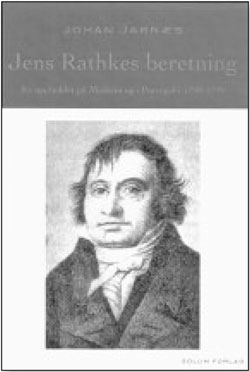Book review: Jens Rathke – a scientific traveller
Michael 2006;3:73–5
Jarnæs J (ed.) Jens Rathkes beretning fra oppholdet på Madeira og i Portugal i 1798–1799. Oslo: Solum, 2005. 293 pp. ISBN 82–560–1506–3. Price: NOK 320,-.

Sometimes, travel diaries may survive for centuries and their contents even gain in interest as time goes by. Here is an example:
The scientist Jens Rathke (1769–1855) was one of the most remarkable personalities in the period when a national academic world should be built up in Norway, following the establishing of a national University in the capital of Christiania in 1811 and the independence from Denmark in 1814.
Rathke was attending the Cathedral School in Christiania until 1787, then moved to Copenhagen, became a student and received his degree in theology from the University of Copenhagen in 1792.
However, in Copenhagen there was a flourishing environment for studies in natural sciences, even if these disciplines were not represented at the University. There was a private society for natural history, where famous scientists, such as the botanist Martin Vahl (1749–1804) and the zoologist Peter Christian Abildgaard (1740–1801) were giving lessons to interested students. Examinations were also arranged. Jens Rathke had been fascinated by natural science, started research on his own, and could already 1794 present an important work on the anatomy of a fresh water mussel (Anodonta anatina). His achievements in natural history made him an obvious choice when the conditions for the fisheries along the Norwegian coast should be studied, and ha was sent out by the government on extensive travels, resulting in reports with lasting value for the development of the Danish-Norwegian, later Norwegian fishing industry.
Rathke was appointed as a teacher in natural history at the Cathedral School in Christiania 1899, a position he never took over because of commitments as a scientific traveller in Norway and Russia, leaving him with a lot of publication work in Copenhagen. In 1810 he was appointed professor at the University of Copenhagen. In 1813 he became professor of zoology in Christiania, one of the very first professors at the new Norwegian University. Here, he also took over teaching obligations in botany and mineralogy and was curator for the new botanical garden, besides pursuing interests in fisheries and in social conditions for the population living in the regions he visited. On of the reasons for his commitments in botany, was that the first professor in Norway in this discipline Christen Smith (1785–1816), another scientific traveller, suddenly died during an expedition to Congo.
After settling in Christiania Rathke obviously became so occupied with practical work that the flamboyant enthusiasm of his youth faded and his publication activities decreased, although he kept on teaching until the age of 75. It might also be that the natural sciences in general developed so rapidly at this time that he felt himself more and more outside the new trends.
However, this book covers a period when his scientific spirits were at their strongest. In the years 1798–1799 he set off for Madeira and mainland Portugal. In these parts of the world, it was generally perceived, there was still a lot of secrets of nature to discover. Perhaps studies of geology even could reveal something about the mechanisms behind earthquakes?
Rathke had been sent out by the society for natural history in Copenhagen, and a lot of preparatory work had been undertaken. Both the society in Copenhagen and their representative Jens Rathke were working in the tradition of Carl von Linné (1707–1778), where the mapping of nature and its constituents, putting the different elements making up our world into a comprehensive system, was a core issue in research and the establishing of new knowledge.
To make a voyage to Madeira in the 1790’ies was no easy task. Rathke at last got the opportunity to travel on board a naval ship, the frigate «Freya» which called at Funchal on its way to the Danish West Indies. During the trip, during the stay in Madeira and during his later stay in continental Portugal, Rathke made meticulous notes. These notes have now been transcribed, carefully edited and published in this book.
What makes the book particularly interesting, are its detailed descriptions of natural objects, people and landscape in the Linnean spirit. Anyone with a command of a Nordic language, planning a trip to Madeira or to Portugal, should supplement the reading of «Let’s go», «Lonely Planet» and other travel literature with this diary by Rathke, written more than two hundred years ago. It is definitely rewarding.
Professor John Peter Collett from the University History Forum in Oslo has written a good introduction which puts the text into context.
To a reader with interests in science history, the book adds to the knowledge about shifting paradigms. Probably, Jens Rathke was one of the last ones of the enthusiastic researchers from the colourful enlightenment period which disappeared together with the 18th century.
Institute of general practice and community medicine
University of Oslo
Po.box 1130 Blindern,
N-0318 Oslo, Norway
oivind.larsen@medisin.uio.no
